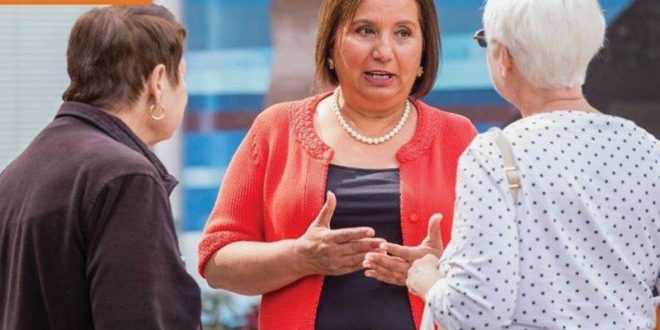Jinny Jogindera Sims is the MLA for Surrey-Panorama. She is the Minister of Citizens’ Services. Before serving these posts, Sims has worked at various government and political positions to serve the community. A teacher, a wife, grandmother, an activist and a minister, Sims has witnessed life in various shades. A teacher by profession, Sims is still a lifelong learner. In an interview with Desi Today, she recalls how her experiences in classroom, made her more determined to bring in changes in society and encouraged her further to join politics.
Please tell us something about your family, your childhood in England and the decision to move to Canada? What were some of the major differences that you noted when you came to Canada?
I was born in Pabwa, near Jullunder, Punjab and grew up in England where I completed my schooling and became a teacher. The politics of the day made my husband and I consider moving away from England so we applied for positions in Canada and ended up moving to Montreal. In 1977we moved to Nanaimo, British Columbia and loved it!
I chose Canada to be my home because of its multiculturalism. I consider myself a true transnational and know that inclusion is not about tolerance; to me true inclusion is about celebrating both our similarities and our differences.
2) How did you decide to join the profession of teaching? What made you enter the leadership positions in various Teachers federations?
Initially I wanted to be an airline pilot but did not meet the height requirement. So I went to university and decided to go into teacher education and since I loved it so much, I decided to become a teacher.
I had a very progressive father who believed we needed a more equal and just society. He taught me to go for my dreams, but to make sure I gave back to my community.
At first, I wasn’t that involved with the Teachers’ Union, but eventually sat on the Status of Women Committee. One day I was asked to step in and sit at the bargaining table while paid maternity leave for women was being negotiated, and we were successful in getting it! Then I was elected as the Vice President for the Nanaimo Teachers’ and the following year became President. In 2000, I was elected to the BCTF executive and served as Vice President then President.
3) What were some of the major challenges that you faced during your service as the BCTF’s president?
With the change in government in the early 2000’s things started to shift quickly in BC. Education funding was decimated, class size and composition was stripped out of our collective agreements, the learning needs of children weren’t being met and teachers, simply put,were tired of giving so much, for fighting what seemed like a losing battle for their students. It was a challenge for the BCTF leadership to start rebuilding that spirit in our membership. We were not only fighting for learning conditions for our students but for our professional rights as teachers and our rights to fair and collective bargaining.
In 2005 teachers voted to strike and were supported by workers, both union and non-union, and received unprecedented support from the public. The strike was about class size, support for students with special needs and fair compensation for teachers.
In November 2016, the Supreme Court of Canada ruled in favour of teachers and restored the language and rights stripped by the BC Liberals. Teachers were vindicated while the BC Liberal government was ruled to have overstepped their jurisdiction.
 4) You also served with the IDEA Network that aims to enhance public education across the Americas. What according to you are some of the major challenges public education is facing across North America?
4) You also served with the IDEA Network that aims to enhance public education across the Americas. What according to you are some of the major challenges public education is facing across North America?
Across the Americas we saw a pattern of underfunding, destabilizing and privatizing public education. Quality public education is the foundation for a vibrant democracy and is the key to economic and social equity. One of the biggest challenges when we came into office was dealing with the legacy of the previous government’s underfunding, the physical neglect of school assets around BC and broken relationships with educators and school boards.
We see that the gaps need to close for vulnerable learners such as Indigenous students, children in care and children with special needs. Poverty plays a key role in student success and until that is fully addressed and every child has the support they need to succeed – to follow their dreams – things won’t change.
As our Premier regularly says, every child needs a quality education with supports so they can be their best. They are our future.
That’s why our government has hit the ground running – we’re investing record levels of funding in education, hiring 3700 new educators, building and upgrading new schools to the tune of over $423 million, and we’re building a new relationship with educators across the province – a relationship built on respect. We’ve also embarked on a poverty reduction strategy to address the needs of British Columbians and close the gaps that vulnerable children and their families face.
5) What is your opinion on increasing violent attacks in schools? You think Canadian schools have any major threats? If yes what do public schools in Canada need to do?
It has been heartbreaking to see the violence occurring in schools in the U.S. Here in BC, we are leaders when it comes to student safety – we’ve been recognized internationally and here in Canada.
Each school district has a critical incident response team to respond to the unlikely event of a violent incident. A provincial team of subject matter experts in violence threat/risk assessment and school violence prevention also provides direct support to schools and school districts on high risk cases and in response to critical incidents.
There are many programs that BC’s Ministry of Education has developed such as the ERASE program which provides an anonymous online reporting tool for students to report threats and violent incidents. The program provides school districts and community partners with comprehensive training in Violence and Threat Risk Assessment to help schools prevent, respond and recover from violent incidents. There’s also the Safer Schools Together provides the comprehensive school safety training program and provincial subject matter expert support to schools and school districts under the ERASE Strategy.
6) After this extensive experience, why did you decide to join politics?
My life experiences seemed to naturally lead me into politics. I have always been very passionate about working closely with people in our communities and as an activist and teacher, my focus has been to build a just and inclusive society. Teaching kids taught me that in order to bring about real change to address poverty, violence, racism, income inequality and such; I had to engage in policy making. In order to build a more just Canada there is a need to have a voice at the table.
7) You have been into the role of an MP and MLA. Do you find any difference in working as an MP and MLA?
I’ve had a long and interesting time in politics from being elected as BCTF President in 2004, to running in the Federal Election in 2011, and then coming to provincial politics with this recent election in 2017. All of my positions have given me the opportunity to work on what I most enjoy – helping to improve the lives of British Columbians and Canadians. As an MP, I held many interesting portfolios, critic of Employment and Social Development Canada, Immigration, and International Cooperation respectively. Now, my knowledge base is continuing to grow through the diverse and meaningful work as Minister of Citizens’ Services and as the MLA for Surrey-Panorama.
8) Surrey Panorama was largely a Liberal dominated riding? What do you think made you win?
I see Surrey-Panorama as a unique and quickly growing constituency where there are so many opportunities to make things easier and more affordable for British Columbians – providing better access to the services people count on and creating good paying jobs in our community and all over the BC. Constituents were concerned about the state of public schools, overcrowding at the hospital, affordability challenges,seniors care, and many more issues were not being addressed by the BC Liberal government and it was time for a change. I think that came across not only in Surrey-Panorama, but all across our province.
There are many things that we have already started doing, and there will be much more to come – we are well on our way to delivering on our promises.
9) Please tell us about your current role as Minister for Citizens’ Services?
I am very excited to have the opportunity of heading this key Ministry as the scope and diverse nature of the responsibilities make it very challenging and immensely rewarding. The Ministry of Citizens’ Services is an extremely important ministry which is interlinked and plays a supportive role to all the other ministries. I like to say we are the face and backbone of government and that people are at the heart of everything we do.
From the facilitation of high-speed internet across the province to Freedom of Information and Protection of Privacy, to providing a wide range of both in-person and online services to British Columbians through our 62 Service BC Centres, we deliver the services British Columbians count on.
We are also responsible for the management of Government Properties and Real Estate services, the BC Procurement Process, BC Online and we provide corporate leadership across government to modernize and manage government’s information technology systems and equipment.
10) What is your take on the problem in the FOI process right now? How do you plan to resolve it?
When I talk to British Columbians, one of the most important things to them is that their government is open and accountable. It’s a key component in my Minister’s mandate letter to improve access to information rules to provide greater public accountability and to improve FOI response times. That’s why we’re not only engaging with our partners and the public to hear their concerns, but we’re examining access to information rules so we can strengthen them.
We’re working hard to improve response and processing timesso the public gets information faster.In fact just since we formed government, I am very proud to say that our on-time FOI response rate has increased to 90 per cent, up from the previous government’s 80 percent. That’s even with a significant increase in the number of FOI requests we’ve seen this fiscal year, which if recent trends continue, are projected to be a 40 to 50 percent increase in the overall volume compared to the last couple of years.
 Desi Today Magazine
Desi Today Magazine




